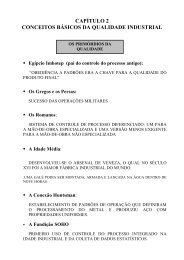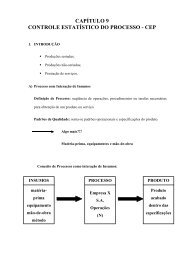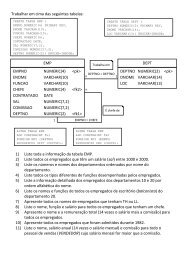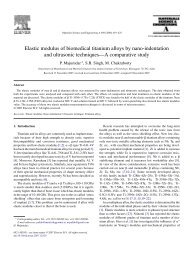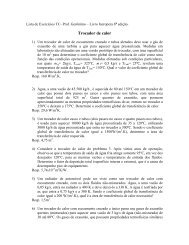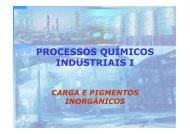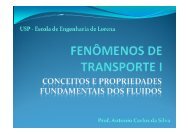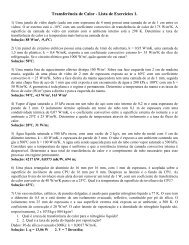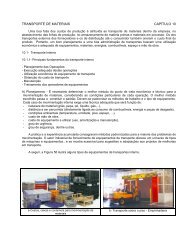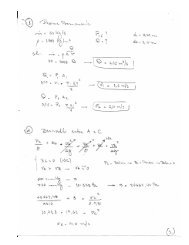CHEMICAL REACTION ENGINEERING A. SARATH BABU - Sistemas
CHEMICAL REACTION ENGINEERING A. SARATH BABU - Sistemas
CHEMICAL REACTION ENGINEERING A. SARATH BABU - Sistemas
Create successful ePaper yourself
Turn your PDF publications into a flip-book with our unique Google optimized e-Paper software.
<strong>CHEMICAL</strong> <strong>REACTION</strong><br />
<strong>ENGINEERING</strong><br />
A. <strong>SARATH</strong> <strong>BABU</strong><br />
1
Course No. Ch.E – 326 <strong>CHEMICAL</strong> <strong>REACTION</strong> <strong>ENGINEERING</strong><br />
Periods/ Week : 4 Credits: 4<br />
Examination Teacher Assessment: Marks: 20<br />
Sessionals: 2 Hrs Marks: 30<br />
End Semester: 3 Hrs Marks : 50<br />
1. KINETICS OF HOMOGENEOUS <strong>REACTION</strong>S<br />
2. CONVERSION AND REACTOR SIZING<br />
3. ANALYSIS OF RATE DATA<br />
4. ISOTHERMAL REACTOR DESIGN<br />
5. CATALYSIS AND CATALYTIC RECTORS<br />
6. ADIABATIC TUBULAR REACTOR DESIGN<br />
7. NON-IDEAL REACTORS<br />
2
TEXT BOOKS<br />
1. Elements of Chemical Reaction Engineering - Scott Fogler H<br />
2. Chemical Reaction Engineering - Octave Levenspiel<br />
3. Introduction to Chemical Reaction Engineering & Kinetics, Ronald<br />
W. Missen, Charles A. Mims, Bradley A. Saville<br />
4. Fundamentals of Chemical Reaction Engineering – Charles D.<br />
Holland, Rayford G. Anthony<br />
5. Chemical Reactor Analysis – R. E. Hays<br />
6. Chemical Reactor Design and operation – K. R. Westerterp, Van<br />
Swaaij and A. A. C. M. Beenackers<br />
7. The Engineering of Chemical Reactions – Lanny D. Schmidt<br />
8. An Introduction to Chemical Engineering Kinetics and Reactor<br />
Design – Charles G. Hill, Jr.<br />
9. Chemical Reactor Design, Optimization and Scaleup – E. Bruce<br />
Nauman<br />
10.Reaction Kinetics and Reactor Design – John B. Butt<br />
3
Without chemical reaction our world would be a<br />
barren planet. No life of any sort would exist.<br />
There would be no fire for warmth and cooking,<br />
no iron and steel to make even the crudest<br />
implements, no synthetic fibers for clothing, and<br />
no engines to power our vehicles.<br />
One feature that distinguishes the chemical<br />
engineer from others is the ability to analyze<br />
systems in which chemical reactions occur and to<br />
apply the results of the analysis in a manner that<br />
benefits society.<br />
4
Automotive catalytic converter<br />
The largest market for chemical reactors is the<br />
automotive catalytic converter (ACC), both in number of<br />
reactors in existence (many million sold/year) and in<br />
amount of reactants processed (millions of tons/year).<br />
There are >50 million automotive catalytic converters<br />
operating throughout the world, and everyone owns one if<br />
he or she has a car less than 10 years old.<br />
The catalytic converter is a<br />
tube wall reactor in which a<br />
noble-metal impregnated wash<br />
coat on an extruded ceramic<br />
monolith creates surface on<br />
which reactions occur.<br />
5
FCC Reactor<br />
The FCC reactor is<br />
without question the<br />
most complex and<br />
important equipment in<br />
chemical engineering.<br />
It is only second to ACC<br />
in amount of reactants<br />
processed.<br />
6
The human reactor<br />
HCl and enzymes (E)<br />
catalyze most reactions.<br />
The food mixes in the stomach (volume 0.5 liter), but its feed is<br />
semibatch: - a transient CSTR.<br />
Next the acidified food passes into the small intestine (a reactor 3/4<br />
in. in diameter and 20 ft long), where it is neutralized and mixed with<br />
more enzymes from the pancreas. This is the primary chemical reactor<br />
of the body, operating with secreted enzymes and with E. coli bacteria<br />
catalysts.
REACTORS occupy a<br />
central role in every<br />
chemical process<br />
It is inside reactors a bulk<br />
of chemical transformations<br />
take place<br />
Introduction 8
• In typical chemical processes the capital and<br />
operating costs of the reactor may be only 10 to<br />
25% of the total, with separation units<br />
dominating the size and cost of the process.<br />
• Yet the performance of the chemical reactor<br />
totally controls the costs and modes of<br />
operation of these expensive separation units,<br />
and thus the chemical reactor largely controls<br />
the overall economics of most processes.<br />
• Improvements in the reactor usually have<br />
enormous impact on upstream and downstream<br />
separation processes.<br />
9
CHALLENGES ?<br />
Chemical engineer never encounters a single reaction in an<br />
ideal single phase isothermal reactor.<br />
Real reactors are extremely complex with multiple<br />
reactions, multiple phases, and intricate flow patterns<br />
within the reactor and in inlet and outlet streams.<br />
An engineer needs enough information to understand the<br />
basic concepts of reactions, flow, and heat management and<br />
how these interact.<br />
The chemical engineer almost never has kinetics for the<br />
process she or he is working on. The problem of solving the<br />
batch or continuous reactor mass-balance equations with<br />
known kinetics is much simpler than the problems<br />
10<br />
encountered in practice.
Reaction rates in useful situations are seldom known, and<br />
even if these data were available, they frequently would<br />
not be particularly useful.<br />
Many industrial processes are mass-transfer limited so<br />
that reaction kinetics are irrelevant or at least<br />
thoroughly disguised by the effects of mass and heat<br />
transfer.<br />
Questions of catalyst poisons and promoters, activation<br />
and deactivation, and heat management dominate most<br />
industrial processes.<br />
We usually encounter an existing reactor that may have<br />
been built decades ago, has been modified repeatedly, and<br />
operates far from the conditions of initial design. Very<br />
rarely we have the opportunity to design a reactor from<br />
11<br />
scratch.
<strong>REACTION</strong> RATES?<br />
Unfortunately, there are no tables of chemical reaction<br />
rates listed in literature.<br />
Useful data tables and correlations can be found in areas<br />
like: thermodynamics, heat and mass transfer, or<br />
separations.<br />
Reaction-rate data do not exist for most technologically<br />
interesting processes.<br />
If someone claims to have a general correlation of reaction<br />
rates, the prudent engineer should be suspicious.<br />
This is the fun (and frustration) of chemical reaction<br />
engineering.<br />
12
Thermodynamics, mass and heat transfer, and separations<br />
can be said to be “finished” subjects for many engineering<br />
applications, whereas every new reaction system must be<br />
examined from first principles.<br />
Most of the process units can be modeled and simulated<br />
using sophisticated computer programs such as ASPEN, but<br />
for the chemical reactors in a process these programs are<br />
not much help unless the kinetics are provided by the user.<br />
The chemical reactor is the least understood and the most<br />
complex “unit” of any chemical process.<br />
Its operation usually dominates the overall operation and<br />
controls the economics of most chemical processes.<br />
13
Systems in which chemical<br />
reactions takes place are<br />
called reactors<br />
Chemical Reaction Engineering<br />
is the engineering activity<br />
concerned with exploitation of<br />
chemical reactions on a<br />
commercial scale<br />
Introduction 14
Objective:<br />
To design a reactor:<br />
• that produces the desired product<br />
safely<br />
• without any adverse environmental<br />
effects<br />
• in an economical manner<br />
• and to a desired specification<br />
15
• Chemical reaction engineering involves the<br />
application of basic chemical engineering principles<br />
to the analysis and design of chemical reactors.<br />
• Many of the operations in a chemical plant –<br />
support the chemical reactor.<br />
• Heat exchange, separations etc. may be used to<br />
pre-treat the reactor feed and then to separate<br />
the reactor effluent into constituent parts.<br />
• A complete understanding of reactor analysis<br />
require – knowledge & understanding of all the<br />
basic chemical engineering principles.<br />
16
Scope<br />
Design & operation of reactors<br />
How fast reactions occur<br />
Chemical Kinetics<br />
Maximum possible yields -TD<br />
Scale of operation<br />
Calvin,Melvin<br />
The true student will seek evidence to establish fact rather than confirm<br />
his own concept of truth, for truth exists whether it is discovered or not.<br />
17
Design of reactors involve:<br />
Choosing the best type of<br />
reactor for a given reaction<br />
Choosing the optimum<br />
operating conditions<br />
Determining the Size of the<br />
reactor<br />
18
The choice of reactors depends on:<br />
• safety<br />
• environment<br />
• profit<br />
Profit depends on:<br />
• raw materials<br />
• initial and operating costs<br />
• market value of the finished<br />
products<br />
19
Physical<br />
treatment steps<br />
Chemical<br />
treatment steps<br />
Physical<br />
treatment steps<br />
Chemical Plant – Our<br />
CRE deals with Chemical treatment steps<br />
Choice of the reactor dictates:<br />
• Pre and post treatment steps<br />
Chemical reactor is the place in the process where the<br />
most value is added: lower-value feeds are converted<br />
into higher-value products.<br />
20
Reactor design require<br />
(all most all core areas of chemical engineering)<br />
Thermodynamics<br />
Chemical Kinetics<br />
Fluid Mechanics<br />
Heat & Mass transfer<br />
Mathematics:<br />
Economics<br />
Introduction 21
Thermodynamics<br />
• Feasibility of a reaction<br />
• Heat of reaction, effect of temperature<br />
• Equilibrium yields, constant, composition<br />
Chemical Kinetics<br />
• Quantitative studies of the rates at which<br />
chemical processes occur<br />
• Factors on which these rates depend<br />
• Reaction mechanism<br />
A description of a reaction in terms of its<br />
constituent molecular acts is known as the<br />
mechanism of the reaction.
Chemical Kinetics & Thermodynamics<br />
• Time is a variable in kinetics but not in<br />
thermodynamics; TD does not deal with respect to<br />
time; equilibrium is a time-independent state.<br />
• Information about the mechanism of chemical change<br />
can be obtained from kinetics but not from<br />
thermodynamics.<br />
• The rate of chemical change is dependent on the path<br />
of reaction; thermodynamics is concerned with “state”<br />
and change of state of a system.<br />
• Chemical kinetics is concerned with the rate of<br />
reaction and factors affecting the rate, and chemical<br />
thermodynamics is concerned with the position of<br />
equilibrium and factors affecting equilibrium.<br />
23
Liquid phase over the gas phase operation<br />
Advantages:<br />
• For the desired product the reactor may be smaller<br />
• The heat capacities and thermal conductivities are<br />
greater for liquids - factors which increase the heat<br />
transfer<br />
• The equipment size is small resulting in lower power<br />
requirements and capital costs.<br />
Disadvantages:<br />
• corrosion and catalyst losses.<br />
• In considering a liquid system, all operating conditions<br />
must fall within the two-phase region<br />
• high operating pressures are potentially hazardous and<br />
expensive to contain<br />
25
How to say a chemical reaction has occurred ?<br />
A chemical species is said to have reacted when it has<br />
lost its chemical identity. The identity of a chemical<br />
species is determined by the kind, number, and<br />
configuration of that species' atoms.<br />
Three ways a chemical species can lose its chemical identity:<br />
1. Decomposition<br />
2. Combination<br />
3. Isomerization<br />
Quiz<br />
26
During a Chemical Reaction<br />
Is mass conserved ?<br />
Are moles conserved ?<br />
Is energy conserved ?<br />
Is volume/density conserved ?<br />
27
Chemical<br />
Biochemical<br />
Homogenous<br />
Heterogeneous<br />
Reversible<br />
Irreversible<br />
Constant Density<br />
Variable density<br />
Classification<br />
of<br />
Reactions<br />
Elementary<br />
Non-elementary<br />
Isothermal<br />
Nonisothermal<br />
Exothermic<br />
Endothermic<br />
Single<br />
Multiple<br />
Catalytic<br />
Noncatalytic<br />
Introduction 28
Classification<br />
Of reactors<br />
Batch /<br />
Continuous<br />
Isothermal /<br />
Non-isothermal<br />
Ideal /<br />
Non-ideal<br />
Homogenous/<br />
Heterogeneous<br />
Introduction 29
Uphill Task<br />
Non–Ideal<br />
Non-isothermal<br />
Heterogeneous React<br />
Multiple Reactors<br />
Multiple Reactions<br />
Variable density<br />
Constant density<br />
Isothermal Reactors<br />
Homogen. Reactors<br />
Single Reactions<br />
Ideal Reactors<br />
Introduction 30
Type of Reactors<br />
Homogeneous<br />
Heterogeneous<br />
Special<br />
Batch<br />
Packed bed<br />
Slurry<br />
Plug Flow<br />
Moving bed<br />
Trickle bed<br />
CSTR<br />
Fluidized bed<br />
Bubble column<br />
Laminar flow<br />
Ebullating Flow<br />
Recycle<br />
Introduction 31
Time line ….<br />
• 1777 Wenzel - first quantitative data on rates of reactions<br />
• 1796 Van Narum – first to recognize catalysis<br />
• 1867 Guldberg & Waage – law of mass action for<br />
homogeneous reactions<br />
• 1877 Van’t Hoff – extended to heterogeneous reactions<br />
• 1889 Arrhenius – concept of activation energy<br />
• 1902 Ostwald – definition of catalyst<br />
• 1920 Taylor – active site catalytic action<br />
• 1923 Lewis & Ries – use of reaction kinetics in the design<br />
of reactors<br />
• 1950 Dankwerts – structure of RTD for analysis<br />
32
Any Questions?<br />
“There is an important question that must be asked when approaching any<br />
difficult project for the first time, and that question is, “Why bother?”<br />
33



